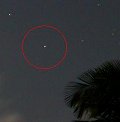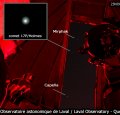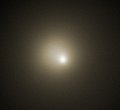| |
| |
Photographer,
Location |
Images |
Comments |
|

|
Odd Høydalsvik,
Bergen, Norway
Oct. 25, 2007 |
#1,
more |
Very strange
comet indeed. The picture was taken at Sandsli outside Bergen,
Norway. October 25, 2007, 20:29 UT+2. Conditions: Thin clouds.
Camera: Canon
EOS 30D. Telescope: William Optics ZenithStar 80 II
ED APO refractor Exposure: 1 sec, f6.8, at 800 ISO, 5 exposures
aligned and stacked manually in PhotoShop CS2. |
|

|
Ilia Teimouri,
Tajrish,Tehran,Iran
Oct. 25, 2007 |
#1,
more |
I can say this
comet is just extra amazing. This is very big, bright and
beautiful. I found and captured image easily with much light
pollution, in Tehran city. I captured these image with Canon
EOS 20D, EQ6 mount and Meade
8" Telescope and edited with Photoshop CS2, also I took
nebula-broadband filter for better resolution. You can see
this comet with the naked-eye when the great moon in the
sky. |
|

|
Jack Dembicky,
Sunspot, New Mexico, USA
Oct. 25, 2007 |
#1 |
Taken with SPIcam on the ARC 3.5m Telescope at Apache Point Observatory
1sec exposure each in MSSSO RGB filters
|
|

|
Jimmy Westlake,
Stagecoach, Colorado USA
Oct. 25, 2007 |
#1,
#2, #3,
more |
Holy smoke! This is one of the weirdest things I've ever seen. Reminiscent of Comet IRAS-Araki-Alcock back in '83, yet strangely different. I wonder what it will do next?
All images made with a Fuji FinePix S2 digital camera at ISO 400.
#1 with 54 mm lens at f4, 64 sec exposure, 12:16 AM MDT
#2 with 300 mm lens at f4, 62 sec exposure, 12:25 AM MDT
#3 with 2100 mm 11" telescope at prime focus, 20 sec exposure, 12:41 AM MDT
|
|

|
Chris
Schur,
Payson, Arizona
Oct. 24, 2007 |
#1,
#2, more |
The
comet was bright yellow with a green halo, very bright in
viewfinder. taken with 12.5" f/5 newtonian and Canon
XTi. |
|

|
Chris Peterson,
Guffey, Colorado, USA
Oct. 25, 2007 |
#1,
more |
These images
were made with a Canon
300D at ISO 200 on a 12"
LX200. The left side is a 1-sec exposure and shows the
sunlight illuminated central coma, very much as it appeared
visually. The right side is a 5-min exposure that shows
the glowing ionized gas in the outer coma. |
|

|
Mick Benedetti,
Mackay, Queensland, Australia
Oct. 26, 2007 |
#1,
more |
I was able to observe this comet at 2:00am, it has no visible tail but with a near full moon I didn't expect to see one. It is planet like with a yellowish colour, a very easy naked eye object to view even with strong moon light. It was a beautiful sight from tropical North Queensland. I snapped the attached photo with my Nikon coolpix 4500.
|
|

|
Michel Renaud,
Laval Observatory (Quebec, Canada)
Oct. 24, 2007 |
#1,
#2, #3,
#4, more |
After our regular astronomy meeting, members of our club went to our Laval Observatory to see this comet. Fantastic event... WOW ! Easy to target.
|
|

|
Philip
Good,
Denver, Colorado, USA
Oct. 25, 2007 |
#1,
more |
Between
11 PM when I went to bed and 4 am when I got up the comet
seemed to have grown by about 25%. Imaged with a Stellarvue
SV115 APO refractor and SBIG ST-10XME CCD Camera. 40 image
each LRGB of 1.5 seconds each. |
|

|
Alan
Friedman,
Buffalo, NY
Oct. 25, 2007 |
#1,
more |
In
my 92mm refractor, 17P/Holmes has the look of a planetary
nebula. In my 10" its core and coma are easily seen. It
shows a golden color - like polished bronze. |
|

|
David
Cardeñosa,
Arroyo de la Encomienda, Valladolid, Spain
Oct. 24, 2007 |
#1,
#2, |
Pictures
taken with Celestron C8 SC, EQ6 mount. Camera Philips SPC900.
Procesed with registax. Fixed picture taken at 22:15UT Animation
from 21:45UT to 22:30UT, show a bit size change. |
more
images (Oct. 24): from
Joe Gafford of Denver, Colorado; from
Anthony Arrigo of Park City, Utah; from
Jeremy Perez of Flagstaff, Arizona; from
John C McConnell of Maghaberry Northern Ireland; from
Malcolm Park of Whitby Ontario Canada, east of Toronto; from
Bob Minor of Berkeley, California; from
Brenda Culbertson of the Crane Observatory, Washburn University,
Topeka, Kansas; from
Tomasz Adam of Staszów, Poland; from
Philippe Boeuf of Near Carcassone, south of France.
|
|